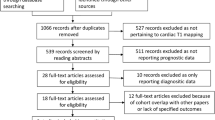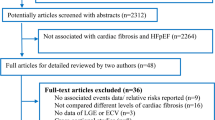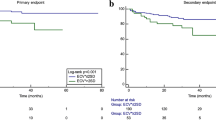Abstract
Heart failure with preserved ejection fraction (HFpEF) accounts for almost one-half of all heart failure (HF) patients and continues to increase in prevalence. While mortality with heart failure with reduced ejection fraction (HFrEF) has decreased over the past few decades with use of evidence-based HFrEF therapy, mortality related to heart failure with HFpEF has not changed significantly over the same time period. The combination of poor prognosis and lack of effective treatment options creates a pressing need for novel strategies for better patient characterization. We conducted a systematic review to evaluate the prognostic value of cardiac magnetic resonance (CMR)–derived T1 relaxation time and extracellular volume fraction (ECV) in HFpEF patients. PubMed, Embase, and Cochrane Central were searched for relevant studies. The primary outcomes of interest were hospitalization for HF and all-cause mortality. Five studies with 2741 patients were included. Four studies reported correlation of outcomes with ECV, 2 studies reported correlation of outcomes with native T1 time, and 1 study reported correlation of outcomes with post-contrast T1 time. All five studies showed significant correlation of CMR-derived parameters with adverse outcomes including event-free survival to cardiac event, all cause, and cardiac mortality. CMR-determined ECV is strongly correlated with adverse outcomes in HFpEF cohorts.

Similar content being viewed by others
References
Paulus WJ, Tschöpe C, Sanderson JE, Rusconi C, Flachskampf FA, Rademakers FE et al (2007) How to diagnose diastolic heart failure: a consensus statement on the diagnosis of heart failure with normal left ventricular ejection fraction by the Heart Failure and Echocardiography Associations of the European Society of Cardiology. Eur Heart J:2539–2550. https://doi.org/10.1093/eurheartj/ehm037
Tsao CW, Lyass A, Enserro D, Larson MG, Ho JE, Kizer JR, Gottdiener JS, Psaty BM, Vasan RS (2018) Temporal trends in the incidence of and mortality associated with heart failure with preserved and reduced ejection fraction. JACC Heart Fail 6:678–685
Owan TE, Hodge DO, Herges RM, Jacobsen SJ, Roger VL, Redfield MM (2006) Trends in prevalence and outcome of heart failure with preserved ejection fraction. N Engl J Med 355:251–259
Steinberg BA, Zhao X, Heidenreich PA, Peterson ED, Bhatt DL, Cannon CP et al (2012) Trends in patients hospitalized with heart failure and preserved left ventricular ejection fraction. Circulation:65–75. https://doi.org/10.1161/circulationaha.111.080770
Abraham WT, Fonarow GC, Albert NM, Stough WG, Gheorghiade M, Greenberg BH, O’Connor CM, Sun JL, Yancy CW, Young JB, OPTIMIZE-HF Investigators and Coordinators (2008) Predictors of in-hospital mortality in patients hospitalized for heart failure: insights from the Organized Program to Initiate Lifesaving Treatment in Hospitalized Patients with Heart Failure (OPTIMIZE-HF). J Am Coll Cardiol 52:347–356
Tribouilloy C, Rusinaru D, Mahjoub H, Soulière V, Lévy F, Peltier M, Slama M, Massy Z (2008) Prognosis of heart failure with preserved ejection fraction: a 5 year prospective population-based study. Eur Heart J 29:339–347
Ponikowski P, Voors AA, Anker SD, Bueno H, Cleland JGF, Coats AJS, Falk V, González-Juanatey JR, Harjola VP, Jankowska EA, Jessup M, Linde C, Nihoyannopoulos P, Parissis JT, Pieske B, Riley JP, Rosano GM, Ruilope LM, Ruschitzka F, Rutten FH, van der Meer P, Authors/Task Force Members, Document Reviewers (2016) 2016 ESC guidelines for the diagnosis and treatment of acute and chronic heart failure: the task force for the diagnosis and treatment of acute and chronic heart failure of the European Society of Cardiology (ESC). Developed with the special contribution of the Heart Failure Association (HFA) of the ESC. Eur J Heart Fail 18:891–975
Yancy CW, Jessup M, Bozkurt B, Butler J, Casey DE Jr., Drazner MH, Fonarow GC, Geraci SA, Horwich T, Januzzi JL, Johnson MR, Kasper EK, Levy WC, Masoudi FA, McBride PE, McMurray JJV, Mitchell JE, Peterson PN, Riegel B, Sam F, Stevenson LW, Wilson Tang WH, Tsai EJ, Wilkoff BL (2013) 2013 ACCF/AHA Guideline for the Management of Heart Failure. J Am Coll Cardiol 62(16):e147–e239
Yancy CW, Jessup M, Bozkurt B, Butler J, Casey DE, Colvin MM et al (2017, 2017) ACC/AHA/HFSA focused update of the 2013 ACCF/AHA guideline for the management of heart failure: a report of the American College of Cardiology/American Heart Association Task Force on clinical practice guidelines and the Heart Failure Society of America. Circulation. https://doi.org/10.1161/cir.0000000000000509
Melenovsky V, Borlaug BA, Rosen B, Hay I, Ferruci L, Morell CH et al (2007) Cardiovascular features of heart failure with preserved ejection fraction versus nonfailing hypertensive left ventricular hypertrophy in the urban Baltimore community. J Am Coll Cardiol:198–207. https://doi.org/10.1016/j.jacc.2006.08.050
Heinzel FR, Hohendanner F, Jin G, Sedej S, Edelmann F (2015) Myocardial hypertrophy and its role in heart failure with preserved ejection fraction. J Appl Physiol 119:1233–1242
Kellman P, Wilson JR, Xue H, Ugander M, Arai AE (2012) Extracellular volume fraction mapping in the myocardium, part 1: evaluation of an automated method. J Cardiovasc Magn Reson. https://doi.org/10.1186/1532-429x-14-63
Miller CA, Naish JH, Bishop P, Coutts G, Clark D, Zhao S, Ray SG, Yonan N, Williams SG, Flett AS, Moon JC, Greiser A, Parker GJ, Schmitt M (2013) Comprehensive validation of cardiovascular magnetic resonance techniques for the assessment of myocardial extracellular volume. Circ Cardiovasc Imaging 6:373–383
Nakamori S, Dohi K, Ishida M, Goto Y, Imanaka-Yoshida K, Omori T, Goto I, Kumagai N, Fujimoto N, Ichikawa Y, Kitagawa K, Yamada N, Sakuma H, Ito M (2018) Native T1 mapping and extracellular volume mapping for the assessment of diffuse myocardial fibrosis in dilated cardiomyopathy. JACC Cardiovasc Imaging 11:48–59
Wells GA, Shea B, O'Connell D, Peterson J, Welch V, Losos M, Tugwell P (2001) The Newcastle-Ottawa Scale (NOS) for assessing the quality of nonrandomised studies in meta-analyses. http://www.ohri.ca/programs/clinical_epidemiology/oxford.asp
Mascherbauer J, Marzluf BA, Tufaro C, Pfaffenberger S, Graf A, Wexberg P et al (2013) Cardiac magnetic resonance postcontrast T1 time is associated with outcome in patients with heart failure and preserved ejection fraction. Circ Cardiovasc Imaging 6:1056–1065
Duca F, Kammerlander AA, Zotter-Tufaro C, Aschauer S, Schwaiger ML, Marzluf BA et al (2016) Interstitial fibrosis, functional status, and outcomes in heart failure with preserved ejection fraction: insights from a prospective cardiac magnetic resonance imaging study. Circ Cardiovasc Imaging 9:e005277
Schelbert EB, Fridman Y, Wong TC, Abu Daya H, Piehler KM, Kadakkal A, Miller CA, Ugander M, Maanja M, Kellman P, Shah DJ, Abebe KZ, Simon MA, Quarta G, Senni M, Butler J, Diez J, Redfield MM, Gheorghiade M (2017) Temporal relation between myocardial fibrosis and heart failure with preserved ejection fraction: association with baseline disease severity and subsequent outcome. JAMA Cardiol 2:995–1006
Roy C, Slimani A, de Meester C, Amzulescu M, Pasquet A, Vancraeynest D et al (2018) Associations and prognostic significance of diffuse myocardial fibrosis by cardiovascular magnetic resonance in heart failure with preserved ejection fraction. J Cardiovasc Magn Reson 20:55
Kanagala P, Cheng ASH, Singh A, Khan JN, Gulsin GS, Patel P et al (2019) Relationship between focal and diffuse fibrosis assessed by CMR and clinical outcomes in heart failure with preserved ejection fraction. JACC Cardiovasc Imaging. https://doi.org/10.1016/j.jcmg.2018.11.031
Moon JC, Messroghli DR, Kellman P, Piechnik SK, Robson MD, Ugander M et al (2013) Myocardial T1 mapping and extracellular volume quantification: a Society for Cardiovascular Magnetic Resonance (SCMR) and CMR Working Group of the European Society of Cardiology consensus statement. J Cardiovasc Magn Reson. https://doi.org/10.1186/1532-429x-15-92
Burt JR, Zimmerman SL, Kamel IR, Halushka M, Bluemke DA (2014) Myocardial T1 mapping: techniques and potential applications. Radiographics. 34:377–395
Puntmann VO, Peker E, Chandrashekhar Y, Nagel E (2016) T1 mapping in characterizing myocardial disease: a comprehensive review. Circ Res 119:277–299
Schelbert EB, Messroghli DR (2016) State of the art: clinical applications of cardiac T1 mapping. Radiology. 278:658–676
Kellman P, Wilson JR, Xue H, Patricia Bandettini W, Shanbhag SM, Druey KM et al (2012) Extracellular volume fraction mapping in the myocardium, part 2: initial clinical experience. J Cardiovasc Magn Reson. https://doi.org/10.1186/1532-429x-14-64
Zeng M, Zhang N, He Y, Wen Z, Wang Z, Zhao Y et al (2016) Histological validation of cardiac magnetic resonance T 1 mapping for detecting diffuse myocardial fibrosis in diabetic rabbits. J Magn Reson Imaging:1179–1185. https://doi.org/10.1002/jmri.25268
Hafstad AD, Lund J, Hadler-Olsen E, Hoper AC, Larsen TS, Aasum E (2013) High- and moderate-intensity training normalizes ventricular function and mechanoenergetics in mice with diet-induced obesity. Diabetes:2287–2294. https://doi.org/10.2337/db12-1580
Samuel CS, Hewitson TD, Zhang Y, Kelly DJ (2008) Relaxin ameliorates fibrosis in experimental diabetic cardiomyopathy. Endocrinology. 149:3286–3293
Jeong D, Lee M-A, Li Y, Yang DK, Kho C, Oh JG et al (2016) Matricellular protein CCN5 reverses established cardiac fibrosis. J Am Coll Cardiol:1556–1568. https://doi.org/10.1016/j.jacc.2016.01.030
Schelbert EB, Sabbah HN, Butler J, Gheorghiade M (2017) Employing extracellular volume cardiovascular magnetic resonance measures of myocardial fibrosis to foster novel therapeutics. Circ Cardiovasc Imaging 10. https://doi.org/10.1161/CIRCIMAGING.116.005619
Fang L, Murphy AJ, Dart AM (2017) A clinical perspective of anti-fibrotic therapies for cardiovascular disease. Front Pharmacol 8:186
Hudson MP, Armstrong PW, Ruzyllo W, Brum J, Cusmano L, Krzeski P et al (2006) Effects of selective matrix metalloproteinase inhibitor (PG-116800) to prevent ventricular remodeling after myocardial infarction: results of the PREMIER (Prevention of Myocardial Infarction Early Remodeling) trial. J Am Coll Cardiol 48:15–20
Holmes DR, Savage M, JM LB (2003) Results of prevention of REStenosis with tranilast and its outcomes (PRESTO) trial. ACC Curr J Rev:59–60. https://doi.org/10.1016/s1062-1458(02)01041-3
Anand I, McMurray J, Cohn JN, Konstam MA, Notter T, Quitzau K et al (2004) Long-term effects of darusentan on left-ventricular remodelling and clinical outcomes in the Endothelin A Receptor Antagonist Trial in Heart Failure (EARTH): randomised, double-blind, placebo-controlled trial. Lancet:347–354. https://doi.org/10.1016/s0140-6736(04)16723-8
Prasad SK, Dargie HJ, Smith GC, Barlow MM, Grothues F, Groenning BA, Cleland JG, Pennell DJ (2006) Comparison of the dual receptor endothelin antagonist enrasentan with enalapril in asymptomatic left ventricular systolic dysfunction: a cardiovascular magnetic resonance study. Heart. 92:798–803
Ho JE, Liu C, Lyass A, Courchesne P, Pencina MJ, Vasan RS, Larson MG, Levy D (2012) Galectin-3, a marker of cardiac fibrosis, predicts incident heart failure in the community. J Am Coll Cardiol 60:1249–1256
Schelbert EB, Fonarow GC, Bonow RO, Butler J, Gheorghiade M (2014) Therapeutic targets in heart failure: refocusing on the myocardial interstitium. J Am Coll Cardiol 63:2188–2198
Author information
Authors and Affiliations
Corresponding author
Ethics declarations
Conflict of interest
The authors declare that they have no conflicts of interest.
Additional information
Publisher’s note
Springer Nature remains neutral with regard to jurisdictional claims in published maps and institutional affiliations.
Michael K. Atalay is a senior author.
Rights and permissions
About this article
Cite this article
Moustafa, A., Khan, M.S., Alsamman, M.A. et al. Prognostic significance of T1 mapping parameters in heart failure with preserved ejection fraction: a systematic review. Heart Fail Rev 26, 1325–1331 (2021). https://doi.org/10.1007/s10741-020-09958-4
Published:
Issue Date:
DOI: https://doi.org/10.1007/s10741-020-09958-4




